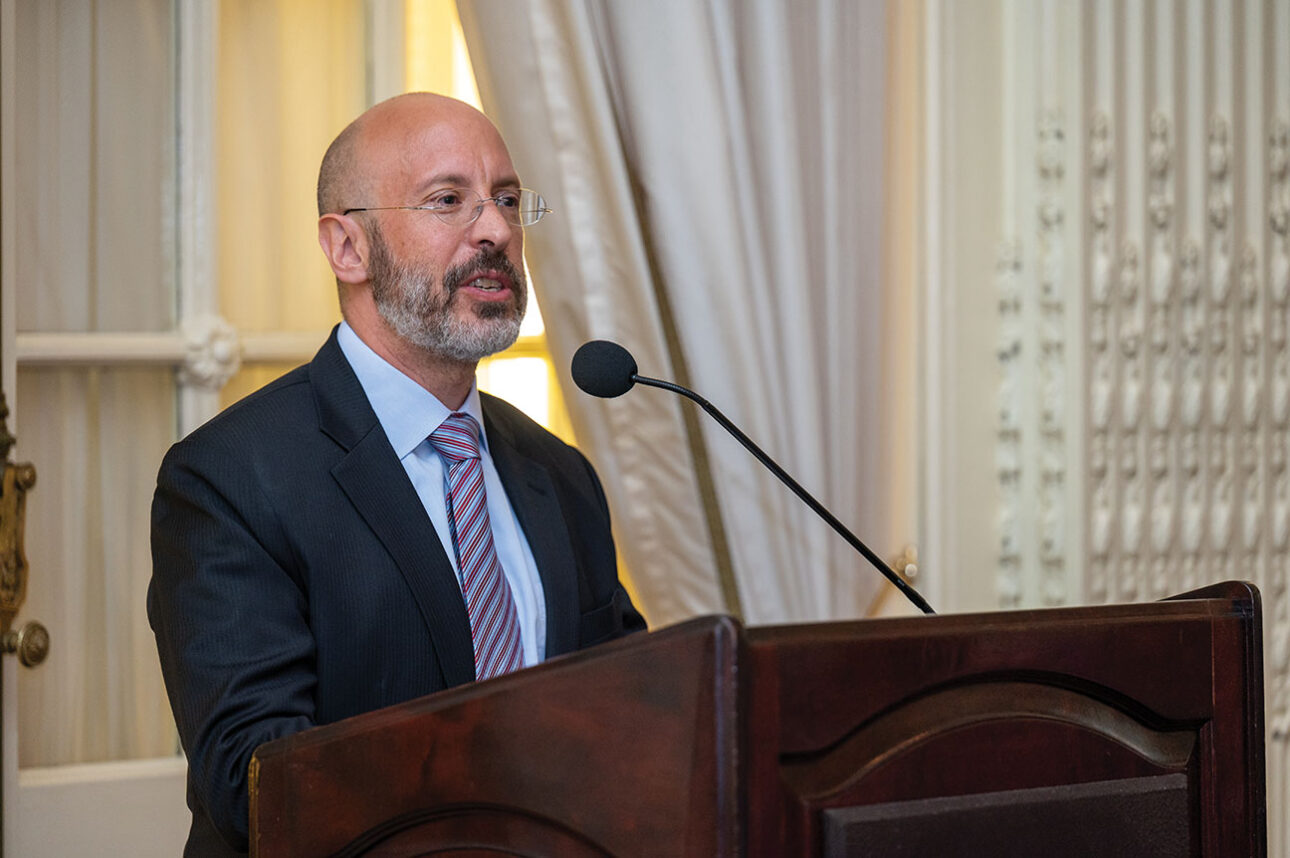Decades after Sigmund Freud probed unconscious human drivesin his case histories, his grandson, Lucian, appeared to do the same on canvas.The 110 works in his retrospective at the Museum of Contemporary Art reveal hissubjects in unflinching, microscopic detail — enough to make grandpa blush.
Human beings slump and sprawl like flayed meat, their bodiesblotchy, skin sagging and genitals revealed. The hefty gay performance artistLeigh Bowery and his friend, “Big Sue,” loll like biological mountains orrejects from a Rubens bacchanal. Other subjects recline, pores and chafe marksexposed, in uncomfortable positions on ramshackle furniture.
In “Painter Working, Reflection (1993),” Freud himselfstands naked and sinewy, feebly wielding a palette knife. Even the queen ofEngland looks bloated and dour in her 2001 portrait.
“Mustn’t be indulgent to the subject matter,” Freud, 80,has said. “I’m only interested in my sitters as animals.”
Like a shrink, Freud — who is routinely called the greatestliving portraitist — doesn’t like to answer personal questions and rarely givesinterviews. But his confidant and biographer, William Feaver, the exhibit’scurator, cheerfully addressed Freud’s pet peeve: comparisons to his famous grandfather.Speaking by telephone from London, Feaver suggested this is why the Jewishartist has never once visited London’s (Sigmund) Freud Museum.
“He doesn’t like that much interpretation placed onpsychoanalysis in his work,” Feaver said. “The parallel people are tempted todraw — that the [sitters] are lying on couches, opening themselves up to thepainter — is just a very convenient coincidence.”
“But Lucian doesn’t see people that way,” Feaver added. “Hesees them as interesting heads and bodies. He is obsessed with painting realpeople in real space, rather than with any thought process, although he doeslook for people who have what you call character.”
Whether or not Freud has absorbed the psychoanalytictradition, he is regarded with the kind of raised eyebrows once elicited by hisgrandfather’s theories. In his adopted home of England, where he has had twowives, umpteen mistresses and nine children, the German-born Jew is as famousas a movie star.
His retrospective earned accolades when it opened atLondon’s Tate Britain on the occasion of his 80th birthday, but hisless-than-flattering portrait of the queen (and the naked pictures he haspainted of his daughters) continue to spark controversy. Last year, Tatlermagazine named Freud the most eligible bachelor (after Prince Harry) and gossipcolumnists tittered over his affair with a 27-year-old journalist.
If he seems to consciously revel in the unconscious sexualappetites his grandfather explored, Feaver begs to differ. He said Freud didn’teven meet the psychiatrist until he was 8, when the father of psychoanalysisbegan trekking to Berlin to undergo treatments for his jaw cancer.
When he visited young Lucian’s apartment near theTiergarten, which sported a maid, nanny and cook, “he was the grand old manwith a little white beard who gave generous tips (cash),” Feaver said. “Heseemed to Lucian very ancient but full of jokes.”
Gifts from grandfather included Bruegel prints and astorybook of “The Arabian Nights” illustrated with Dulac watercolors. WhenLucian visited the elder Freud’s home, he fingered the small artifacts thatmade up the psychiatrist’s beloved antiquities collection.
As he grew older, he didn’t read much of grandpa’spsychoanalytic work, although he adored Sigmund Freud’s controversial “Mosesand Monotheism,” which suggested Moses was an Egyptian. “An outrageous book:His final kick at the Talmud,” Freud has said.
“Like his grandfather, Lucian has this mischievous streak,”Feaver said. “He likes expectations to be upset.”
The Freuds were Jewish but nonpracticing, which didn’tprevent the Nazis from closing the architectural practice of Ernst Freud,Lucian’s father, in 1933. The budding painter witnessed “nasty remarks andbullying,” although his description of the time tends to be blase.
Freud has recounted how, as one of two Jews at his school,he was “ineligible for Hitler Youth but was told he wasn’t missing much, thoughthe sausages were good,” Feaver wrote in the exhibition catalogue. Freud’sbiographer believes this kind of breezy remark demonstrates “how Lucian haslearned the British art of understatement, of making light of things, whichactually connotes strong feeling.”
Nevertheless, Freud “considers himself an emigre, not avictim,” Feaver said. “And he’s always been very, very keen on being a kind ofanarchist and living by his own rules.”
That predilection was evident when the Freuds relocated toEngland in the late summer of 1933, and the budding artist was expelled fromtwo schools, one of them for dropping his trousers in public on a bet. On a tipfrom a girl in a coffee bar, he eventually enrolled in the East Anglian Schoolof Drawing and Painting, where he learned that a portrait could be “revealingin a way that was almost improper,” Feaver said.
After a traumatic stint as a seaman (his convoy was attackedby Germans), Freud was further disturbed by newsreels of concentration camps in1945.
The New Statesman has suggested his painterly “mission has… been to save, in all their ordinary power and imperfect, heartbreakingbeauty, some of the millions of bodies lost and broken in the war.” Feaverdoesn’t think so.
He points out that Freud’s subjects are friends, lovers andacquaintances who sit for up to 150 hours in his shabby studio.
“People say, Lucian’s [subjects] look exhausted andmiserable because they are hunted, but they’re not,” he said. “They’re sleepyand unsmiling because they’ve been posing for so long.
There are, of course, other reasons: In “Hotel Bedroom1954,” Freud’s second wife, Caroline Blackwood, lies in bed like a jaundicedwaif, as her brooding husband looms against closed shutters.
In “Interior in Paddington (1951)” a desiccated-looking manstands next to a wizened potted palm tree that could be his vegetable twin.
When Freud’s mother attempted suicide after her husband’sdeath in 1970, the artist began driving her to his studio to paint her, in partto keep his eye on her. (The painter previously avoided her because she was”the quintessential Freudian, obsessive mother,” Feaver said.) The resultingseries of portraits depicts the former grande dame as passive anddeteriorating.
As to why Freud is preoccupied with sagging flesh, Feaver said,”Because it’s more interesting. People go on and on about the stretch marks,but to Lucian’s mind, bodies are what they are. One of his principals is thatpeople shouldn’t disguise themselves. And once we get past the acne stage, weall sag.”
More than 60 years after the death of his famousgrandfather, Freud continues to earn his own accolades by meticulously paintingfriends, lovers and acquaintances for up to 10 hours a day in his fifth-floorwalk-up studio.
“He wants to paint himself to death,” Feaver said. “He’salways felt he’s trying to beat the clock, and there’s this urgency to keep atit.”
For information about the exhibit, through May 25, call(213) 626-6222. For related programs, call (213) 621-1745.






















 More news and opinions than at a Shabbat dinner, right in your inbox.
More news and opinions than at a Shabbat dinner, right in your inbox.